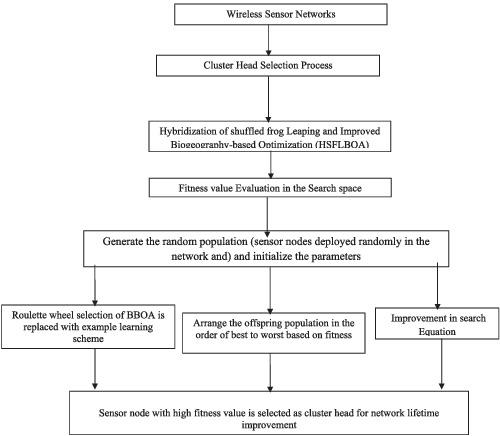当前位置:
X-MOL 学术
›
Int. J. Commun. Syst.
›
论文详情
Our official English website, www.x-mol.net, welcomes your
feedback! (Note: you will need to create a separate account there.)
Hybrid shuffled frog leaping and improved biogeography‐based optimization algorithm for energy stability and network lifetime maximization in wireless sensor networks
International Journal of Communication Systems ( IF 1.7 ) Pub Date : 2021-01-04 , DOI: 10.1002/dac.4722 Narayanasamy Tamilarasan 1 , S.B. Lenin 2 , N. Jayapandian 3 , P. Subramanian 4
International Journal of Communication Systems ( IF 1.7 ) Pub Date : 2021-01-04 , DOI: 10.1002/dac.4722 Narayanasamy Tamilarasan 1 , S.B. Lenin 2 , N. Jayapandian 3 , P. Subramanian 4
Affiliation

|
Wireless sensor networks are significantly used for data sensing and aggregating dusts from a remote area environment in order to utilize them in a diversified number of engineering applications. The data transfer among the sensor nodes is attained through the inclusion of energy efficient routing protocols. These energy efficient routing necessitates optimal cluster head selection procedure for handling the challenge of energy consumption to extend the stability and lifetime in the sensor networks. The implementation of energy efficient routing is still complicated even when the process of clustering is enhanced through the cluster head selection. The majority of the existing cluster head selection schemes suffer from the issues of poor selection accuracy, increased computation, and duplicate nodes' selection. In this paper, hybrid shuffled frog leaping and improved biogeography‐based optimization algorithm (HSFLBOA) for optimal cluster head selection is proposed for resolving issues that are common in cluster head selection schemes. This proposed HSFLBOA used the objective function that used the parameters of node energy, data packet transmission delay, cluster traffic density, and internode distance in the cluster. The simulation results of the proposed HSFLBOA is determined to be significant in achieving superior throughput and network energy compared to benchmarked metaheuristic optimal cluster head schemes.
中文翻译:

混合改组蛙式跳跃和基于生物地理学的改进优化算法,可实现无线传感器网络中的能量稳定性和网络寿命最大化
无线传感器网络显着地用于数据感测和聚集来自偏远地区环境的灰尘,以便将其用于多种工程应用中。传感器节点之间的数据传输是通过包含节能路由协议来实现的。这些节能路由需要最佳的簇头选择程序,以应对能耗的挑战,以延长传感器网络的稳定性和使用寿命。即使通过簇头选择来增强簇的过程,节能路由的实现仍然很复杂。现有的大多数簇头选择方案都存在选择精度差,计算量增加以及节点重复选择的问题。在本文中,为了解决簇头选择方案中常见的问题,提出了一种混合混洗蛙跳和改进的基于生物地理学的优化算法(HSFLBOA),用于最优簇头选择。该拟议的HSFLBOA使用目标函数,该函数使用节点能量,数据包传输延迟,集群流量密度和集群中节点间距离的参数。与基准的元启发式最佳簇头方案相比,拟议的HSFLBOA的仿真结果被认为对于实现更高的吞吐量和网络能量具有重要意义。该拟议的HSFLBOA使用目标函数,该函数使用节点能量,数据包传输延迟,集群流量密度和集群中节点间距离的参数。与基准的元启发式最佳簇头方案相比,拟议的HSFLBOA的仿真结果被认为对于实现更高的吞吐量和网络能量具有重要意义。该拟议的HSFLBOA使用目标函数,该函数使用节点能量,数据包传输延迟,集群流量密度和集群中节点间距离的参数。与基准的元启发式最佳簇头方案相比,拟议的HSFLBOA的仿真结果被认为对于实现更高的吞吐量和网络能量具有重要意义。
更新日期:2021-02-03
中文翻译:

混合改组蛙式跳跃和基于生物地理学的改进优化算法,可实现无线传感器网络中的能量稳定性和网络寿命最大化
无线传感器网络显着地用于数据感测和聚集来自偏远地区环境的灰尘,以便将其用于多种工程应用中。传感器节点之间的数据传输是通过包含节能路由协议来实现的。这些节能路由需要最佳的簇头选择程序,以应对能耗的挑战,以延长传感器网络的稳定性和使用寿命。即使通过簇头选择来增强簇的过程,节能路由的实现仍然很复杂。现有的大多数簇头选择方案都存在选择精度差,计算量增加以及节点重复选择的问题。在本文中,为了解决簇头选择方案中常见的问题,提出了一种混合混洗蛙跳和改进的基于生物地理学的优化算法(HSFLBOA),用于最优簇头选择。该拟议的HSFLBOA使用目标函数,该函数使用节点能量,数据包传输延迟,集群流量密度和集群中节点间距离的参数。与基准的元启发式最佳簇头方案相比,拟议的HSFLBOA的仿真结果被认为对于实现更高的吞吐量和网络能量具有重要意义。该拟议的HSFLBOA使用目标函数,该函数使用节点能量,数据包传输延迟,集群流量密度和集群中节点间距离的参数。与基准的元启发式最佳簇头方案相比,拟议的HSFLBOA的仿真结果被认为对于实现更高的吞吐量和网络能量具有重要意义。该拟议的HSFLBOA使用目标函数,该函数使用节点能量,数据包传输延迟,集群流量密度和集群中节点间距离的参数。与基准的元启发式最佳簇头方案相比,拟议的HSFLBOA的仿真结果被认为对于实现更高的吞吐量和网络能量具有重要意义。











































 京公网安备 11010802027423号
京公网安备 11010802027423号